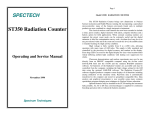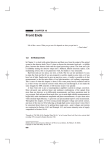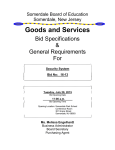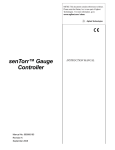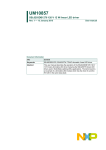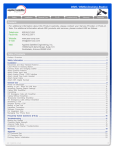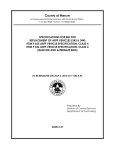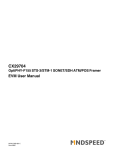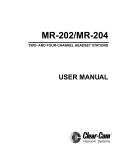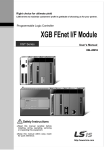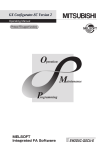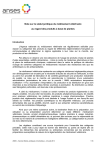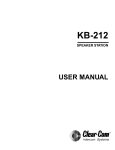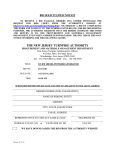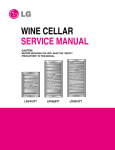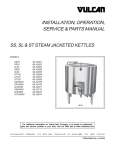Download ST150 Nuclear Lab Station SPECTECH - TEL
Transcript
Page 1 SPECTECH ST150 Nuclear Lab Station Operating and Service Manual Model ST150 Nuclear Lab Station The ST150 Nuclear Lab Station provides a self-contained unit that includes a versatile timer/counter, GM tube, sample stand, and an 11 piece absorber set. The unit comes complete with a serial interface to either Macintosh or IBM compatible personal computers. High voltage is fully variable from 0 to +800 volts. The supply is fully regulated and controlled by the processor for digital accuracy and readout on the display. Extra large LED's are used for the digital display for clear visual readout under widely differing ambient light conditions with leading zero suppression for clarity. Classroom demonstrations and nuclear experiments may now be run directly from an IBM-PC or Apple Macintosh compatible computers using the on-line serial DATALINK built into the ST150 and the NUCLAB emulation software. Counting functions may be initiated from the ST150 or the computer. The software supplied produces computer screen displays of all functions including analog and digital emulation of a ratemeter. Real-time data is automatically transferred to the computer and stored in spreadsheet compatible files. Data analysis and graphical presentation are now possible using many common spreadsheet programs bringing new techniques to Nuclear Science education. An AC to DC line converter is supplied for continuous benchtop operation. Warranty Spectrum Techniques warrants products of our manufacture against defects in workmanship or material for a period of one year from date of shipment. We will repair or replace at our option, any instrument that is deemed to be defective during this period. This warranty fully covers all replacement parts and labor. The instrument must be returned to our factory prepaid and we in turn will pay the cost of return shipping . This warranty does not cover damage caused by mishandling or misuse. GM tubes with broken windows are specifically excluded from this warranty. Accessory items not manufactured by Spectrum Techniques but supplied as part of our systems will be subject to the original manufacturers warranty. April 1996 Page 2 Specifications. Input: Built in Geiger Mueller tube: 15 mm diameter, 1.52 mg/cm.² window, 500V operating, 150V plateau. High voltage: 0 to +800 volts, digitally selectable in 20 volt increments. Display: 6-decade LED, 1 in. numerals. Displays counts, time, and high voltage. Modes: Count for preset time, set and view preset time, and set and view high voltage 0-800v. Data Link: DB-9 male connector accepts RS-232 serial cable to IBM-PC compatible, and DB-9 female accepts DIN cable for Macintosh computers. Absorbers: 11 piece set, 6-7400 mg/cm². Sample holder: 6 position, 1cm spacing. Power: Input 9 volt DC, at 500mA from AC adapter. Specify 110-120, 220-240 VAC at time of order. Dimensions: 10 in. W, x 7.5 in. H, x 6.2 in. D. Software supplied: ST150 Nuclear Lab - PC emulation DOS program runs with or without Windows on most IBM compatible PC's. Requires EGA or better graphics capability. Optional Macintosh software runs under MultiFinder under System 6.0 and later and also runs under System 7.x. All software provides real-time display of simulated analog or digital ratemeter in CPM or CPS, count, elapsed time, preset time, high voltage setting, acquisition time, and run number. Data is saved to spreadsheet compatible files. Bi-directional control offers computer control of count start/stop and data transfer. Page 3 Operation Page 3 CAUTION The detector window is extremely thin and fragile. If broken it cannot be repaired and will not be covered under the warranty. Never allow objects to touch the window. Page 4 Operating Modes and Controls. COUNT. This is the normal operating mode where the display registers the number of radiation events detected by the GM tube. Before starting a count, a preset time may be entered using the TIME and UP/DOWN buttons. To begin the count interval press the COUNT button. Any existing count and elapsed time will be automatically cleared. If a preset time has been entered, the unit will count until the preset time is reached. General. STOP. This button will stop the current count. The ST150 Radiation Counter may only be operated with the AC adapter provided or with one of identical specifications. The sample holder provides six positions with 1 cm. separation between each for placement of radioactive sources and absorbers. 11 absorbers are provided for use in radiation absorption experiments. Absorbers may be placed in empty sample holder slots between the source and the detector. TIME. If the operator wishes to count radiation events for a predetermined time, a preset time may be entered by pressing TIME and entering the required counting time in seconds using the UP/DOWN buttons. To return to count display mode press TIME again. Detectors. HIGH VOLTAGE. The high voltage setting on the GM tube may be set by pressing the H.V. button. The current setting will be displayed. The high voltage may be adjusted in 20 volt increments using the UP/DOWN buttons between 0 and 800 volts. To return to count display mode press H.V. again. Geiger-Mueller tubes produce electrical pulses when ionizing radiation events occur within their sensitive volume. For proper operation, these detectors should be run at a predetermined operating voltage specified by the manufacturer or derived empirically. To improve sensitivity to alpha and beta particle radiation, many GM tubes have extremely thin entrance windows which require considerable care in handling. Do not allow any object to come in contact with the GM tube mounted in the top of the sample holder. T h e ST150 includes a fully adjustable high voltage power supply to cover a wide range of applications. The high voltage level may be displayed on the digital readout by pressing the H.V. button once. Adjustments to the high voltage may then be made in 20 volt increments using the UP/DOWN buttons. To return to count display mode press H.V. again. Page 5 Page 6 Operation. GM Plateau. Basic operation of the model ST150 Radiation Counter is straightforward and intuitive. The correct operating voltage for the Geiger-Mueller tube may be determined experimentally using a small radioactive source such as Cs-137 or Co-60. A properly functioning tube will exhibit a "plateau" effect, where the counting rate remains nearly constant over a range of applied voltage. Place the radioactive source close to the window of the GM probe and slowly increase the high voltage until radiation events just begin to be detected. Now increase the voltage in 20 volt steps recording the counting rate at each increment. The rate should remain fairly constant over a range of voltage and then increase rapidly as the high voltage is further raised indicating that the tube is entering the breakdown region. Do not continue to operate the tube in this breakdown condition but reduce the high voltage and make a plot of the counting rate versus the applied voltage. The recommended operating voltage may now be determined as the center of the plateau region. In the example below note that the plateau extends from approximately 350V to 600V. A reasonable operating voltage in this case would be 500V. If no other presets are required, press H.V. again to return to the count display mode. Operation may now be controlled with the START and STOP buttons. Pressing TIME will display the acquisition time in seconds. To count for a preset time, press the TIME button and enter the required counting time in seconds using the UP/DOWN buttons. Once set the preset time will remain unchanged unless the UP/DOWN buttons are pressed again. Start the count with the COUNT button. The count may be stopped before the preset time is reached by pressing the STOP button. Once the preset time is reached the counter will stop accumulating data. At this point it is only necessary to press COUNT to restart the next cycle as the preset will automatically be restored and the count register reset to zero. If the ST150 is linked to a computer running the NUCLAB software, data will be automatically transferred to the computer whenever a count stops either by reaching the preset time or pressing the STOP button. If however, the count is stopped by remote control from the computer the data is NOT automatically transferred. This allows a single run in a multiple run experiment to be repeated before it is stored. GM Plateau 6000 5000 4000 Counts First set the high voltage to the recommended value for the GM tube using the H.V. and UP/DOWN buttons. 3000 2000 1000 0 0 200 400 600 High Voltage 800 1000 Page 7 Page 8 Resolving Time. Applications. Geiger-Mueller tubes exhibit dead time effects due to the recombination time of the internal gas ions after the occurrence of an ionizing event. The actual dead time depends on several factors including the active volume and shape of the detector and can range from a few microseconds for miniature tubes, to over 1000 microseconds for large volume devices. When making absolute measurements it is important to compensate for dead time losses at higher counting rates. If the resolving time of the detector is known, the true counting rate may be calculated from the measured rate using the following expression: The ST150 may be used for a variety of applications some of which are listed below. Surface contamination measurement. Plotting a GM plateau. Radiation background measurement. Natural radioactivity. n= m/1-mt GM resolving time. where n is the true counting rate, m the measured rate, and t the detector resolving time. If the detector resolving time is unknown, it may be determined experimentally using two radioactive sources. Maintaining constant counting geometry is important throughout the experiment. A special source split into two halves is available for making the measurement, but good results may be obtained by careful positioning of two standard check sources. With the high voltage correctly set for the GM tube, position the two sources (a+b) side by side to obtain a count rate of at least 10,000 CPM. Accurately record the Detector efficiency. Radiation absorption studies. Backscattering. Inverse square law. Isotope half life. countrate as R(a+b). Remove source (b) and record the count rate as R(a). Carefully replace source (b) to its original position, remove source (a) and Radiation properties. record the count rate of source (b) as R(b). The resolving time is given by Counting statistics. R(a)+R(b)-R(a+b) T= 2R(a).R(b) The resolving time of the ST150 Nuclear Lab Station is very short and is not a significant factor compared to that of the GM tube. Page 9 Page 10 NucLab Nuclear Lab Station Software for IBM PC Compatibles Maintenance. CAUTION Dangerous voltages can exist inside the ST150 from the high voltage power supply. Before removing the cover ensure the instrument is in the OFF position and the high voltage is set to zero. Only qualified technicians should attempt any repairs. Your ST150 Radiation Counter is supplied with a computer communication and control software package named NUCLAB. Command and data are transferred via the standard RS 232C serial port, and require connection to the computer’s COM 1 or COM 2 port. NUCLAB allows counting control of the ST150 from either the front panel buttons or the computer system. To run NucLab insert the program disk supplied into drive A, type A: NUCLAB and the following screen will appear: Your ST150 has been built with care using quality parts and should not require any routine service. In the unlikely event of a malfunction, the unit may be returned to the factory for repair. We will gladly supply a cost estimate if the warranty period has expired. A complete list of parts is included for your convenience. Please contact our customer service department for pricing and availability. In many instances substitute parts may be used providing they meet or exceed the original specifications. Select the appropriate COM port and continue. The COUNT and STOP controls on the ST150 front panel are repeated on the main NucLab screen and will remotely control those operations on the unit. Other features of the software are invoked from their selection within the menu system. Features and menu selections are made by clicking on the selection with a mouse or by pressing the key corresponding to the underlined character in the selection. Page 11 Page 12 NucLab contains an on-screen help menu for guidance through the basic operations. The Help system provides hypertext allowing topics to be quickly accessed. To invoke the Help system choose Help Contents from the Help menu bar selection. Click on any highlighted text to see an explanation of the feature. Highlighted text may also be selected by pressing TAB until the desired selection is indicated. the number of entered runs have completed. When all of the desired data has been collected, the data may be saved to a spreadsheet compatible text file by choosing the Save selection from the File menu. The extension defaults to . TSV to indicate a Tab Separated Value file format. This format allows the collected data to be directly imported into most speadsheets with the run number, voltage, count, elapsed time, and time of day information correctly separated into columns. Several different VIEW modes are possible including analog ratemeter and digital counter/timer with CPM or CPS selection. When counting is stopped on the ST150 either by pressing STOP or by reaching a preset time, the latest count data will be transferred to the computer. If a count is interrupted by clicking the STOP icon on the NucLab screen the data will be not transferred. This allows a count to be interrupted and restarted without being saved on the computer. To force a count to be saved as a legitimate data run press the Insert (Ins) key. From the Presets pull down menu a number of automated data runs may be invoked by choosing Set Preset Runs. After the number of desired runs is entered pressing the COUNT button on the ST150 or clicking the Count icon from the software will initiate the first count. When the preset time is reached, the data will be transferred to the computer, the elapsed time and counter will be cleared and the next count interval will begin. This process continues until In the event of a breakdown in the communication between the ST150 and the computer the link may be reestablished if possible by choosing Serial Relink from the Presets menu. If this fails to reestablish communications, try powering down both the ST150 and the computer to fully reset the serial port. G1500 REV3 SPECTRUM TECHNIQUES 1995 A WP1 1 VAL SW1 C2 C3 R1 1 1 J1 VI C1 C2 C1 C B 1 2 VAL 3 U1 VO G D E F G H +5V 1 LM7805CTB C2 C3 C1 10uF WP2 C4 .1 .1 1 C5 C6 C7 .1 .1 C8 C9 .1 .1 I1 .1 SEGA SEGF SEGE SEGD .1 GND 1 2 7 8 9 10 11 13 14 SEGC SEGG SEGB GND I2 SEGA SEGF SEGE SEGD CA CF CE CD DP CC CG CB A 1 2 7 8 9 10 11 13 14 SEGC SEGG SEGB C B C 1 2 7 8 9 10 11 13 14 SEGC SEGG SEGB C 1 2 7 8 9 10 11 13 14 SEGC SEGG SEGB 1 2 7 8 9 10 11 13 14 SEGC SEGG SEGB CA CF CE CD DP CC CG CB A LR1720R C B Q6 B 2N3906 E R5 51 SEGA SEGF SEGE SEGD CA CF CE CD DP CC CG CB A Q5 2N3906 E I6 LR1720R C B R4 51 SEGA SEGF SEGE SEGD CA CF CE CD DP CC CG CB A Q4 2N3906 E I5 LR1720R B R3 51 SEGA SEGF SEGE SEGD CA CF CE CD DP CC CG CB A Q3 2N3906 E I4 LR1720R B R2 +5V SEGC SEGG SEGB Q2 2N3906 E 1 2 7 8 9 10 11 13 14 LR1720R Q1 2N3906 SEGA SEGF SEGE SEGD CA CF CE CD DP CC CG CB A LR1720R C I3 E R6 51 R7 51 51 +5V 2 2 1 6 CN1 C11 1 2 3 4 5 6 7 8 9 DB9M 2 V C C V+ .1 1 U3 C1+ 14 1 WP4 7 1 13 WP5 1 8 T1OUT T1IN T2OUT T2IN R1IN R1OUT R2IN DS6 DS5 DS4 MAX232 C2+ 6 G N D V- .1 C2- 11 R8 10 CTS 12 RXD +5V U2:A CLED 5 C13 WR* CTS CNT HV TIME TXD RXD 17 16 15 14 13 12 11 10 AB12 AB11 AB10 AB9 AB8 28 27 26 25 24 23 22 21 3 PSEN* ALE 29 30 P17 P16 P15 P14 P13 P12 P11 P10 P3 7 / RD P3 6 / WR P35/T1 P34/T0 P3 3 / INT1 P3 2 / INT0 P31/TXD P30/RXD P27/A15 P26/A14 P25/A13 P24/A12 P23/A11 P22/A10 P21/A9 P20/A8 P07/AD7 P06/AD6 P05/AD5 P04/AD4 P03/AD3 P02/AD2 P01/AD1 P00/AD0 PSEN ALE EA RST 18 XTAL2 XTAL1 8 7 6 5 4 3 2 1 STOP START + SA3 SA2 SA1 SA0 32 33 34 35 36 37 38 39 AD7 AD6 AD5 AD4 AD3 AD2 AD1 AD0 31 1 27 20 22 PSEN* 10 9 8 7 6 5 4 3 25 24 21 23 2 A0 A1 A2 A3 A4 A5 A6 A7 AB8 AB9 AB10 AB11 AB12 +5V U2:D VPP PGM E G A0 4 3 3 2 4 3 AD0 AD1 AD2 AD3 AD4 AD5 AD6 AD7 11 12 13 15 16 17 18 19 AD0 AD1 AD2 AD3 AD4 AD5 AD6 AD7 2 4 3 4 3 47 C15 STOP ALE C16 AD0 AD1 AD2 AD3 AD4 AD5 AD6 AD7 GND HV TIME 1 11 3 4 7 8 13 14 17 18 1D 2D 3D 4D 5D 6D 7D 8D 4 3 AD0 AD1 AD2 AD3 AD4 AD5 AD6 AD7 .01 C27 C20 R16 R17 10 7447 SEGD 10 R18 R19 10 12 SEGC SEGE 4 SEGF SEGG 10 1 11 3 4 7 8 13 14 17 18 OC CLK 1D 2D 3D 4D 5D 6D 7D 8D +5V TLED HVLED CLED 2 5 6 9 12 15 16 19 1Q 2Q 3Q 4Q 5Q 6Q 7Q 8Q +5V .01/1KV R20 R21 1M 5.1K .1 C18 GND T1 S1 1 WP9 P2 S2 1 D1 K A D2 K A D3 D6 1N4004 1N4004 K A 1N4004 D4 K A D5 C23 .01/1KV 1N4004 .01/1KV .01/1KV D7 1N914 A WP11 +5V 1 R33 100 2N3906 R32 GND 2 WP12 22M 1M SIG 100 1 1 R30 R31 TB1 1 GND MC3405P 5.1M Q7 5 R25 2 R22A 22M 5.1K 1 47K 47pF/1KV R26 CNT R27 4 3 R22 1N4004 C24 C22 VAL VCC 1N4004 U10:A R23 C21 3.3M K K 1 GND 3K R45 GND GM-15 U10:D Q8 10K B +5V E R46 100K C 1K R37 D8 1N914 D9 13 6 R40A R40 MC3405P 10uF R36 22M 22M 62K D10 .001 - R42 100K R41 1.00K CW + 1N914 R47 U12 9 14 R43 CCW +5V 1.00K 10K 10 U10:C MC3405P 16 1 2 R34 R38 1.00K 3 4.22K 5 WR CS DB0 RFB DB1 DB2 OUT1 DB3 OUT2 DB4 DB5 DB6 GND DB7 VREF GND SN74LS32N VDD 13 12 11 10 9 8 7 6 5 4 6 GND 4 AD0 AD1 AD2 AD3 AD4 AD5 AD6 AD7 ST 150 COUNTER Size U2:E A2 11 Filename E Rev F G 3 G1500 Date 3/22/96 GND D Number A1 10 74LS04 .1 6 Title U4:B WR* TLC7524CN C28 GND 15 D11 W C +5V 8 GND B 1N914 C29 10uF C31 Changed R22 22M>>3.3M 5-2-02 Added R22A <5.1M> 5-2-02 51K GND 14 1N914 MPSA64 R35 1 1.00K 12 C30 A 10 .01/1KV P1 R39 .01 10 WP7 LM555CHC C26 13 12 11 10 9 15 14 a b c d e f g A B C D U2:F 74LS374 1.8k 1 R15 SEGB U13 C17 A R28 7 1 2 6 BI/ RBO RBI LT 74LS04 U4:C GND 2 WP8 3 R14 9 .01/1KV 4.7K SA0 SA1 SA2 SA3 10 U9 8 C19 RESET TRIG THR OUT CONT DIS R13 4 5 3 A0 A1 A2 A3 A4 A5 A6 A7 2 5 6 9 12 15 16 19 1Q 2Q 3Q 4Q 5Q 6Q 7Q 8Q 13 + GND 4 2 6 5 7 5.1K WR* +5V R29 DS1 DS2 DS3 DS4 DS5 DS6 2 5 6 9 12 15 16 19 1Q 2Q 3Q 4Q 5Q 6Q 7Q 8Q 74HC374 R12 OC C A1 S6 1 WP10 1D 2D 3D 4D 5D 6D 7D 8D 10 2 GND 3 LED3 SEGA S5 1 1 6 74LS04 U8 SN74LS32N R24 2K TIME OC CLK 3 4 7 8 13 14 17 18 5.1K S4 1 1 11 +5V 74LS373 4 LED2 R11 S3 1 R10 4 5 U7 GND 1UF 12MHz S2 4 TLED U4:A Q1 Q2 Q3 Q4 Q5 Q6 Q7 Q8 GND 2 3 74LS04 U2:C 1 START 47 1 HVLED 2K H.V. 3 X1 2 LED1 U2:B 2 C14 9 8 SN74LS32N GND 19 9 WR* 2764-17 S1 R9 2 74LS04 74LS04 A0 A1 A2 A3 A4 A5 A6 A7 A8 A9 A10 A11 A12 U5 1 1 U6 P-80C32 4 GND 8 2K COUNT 9 .1 U11 +5V DS1 TXD 1 5 5 DS2 .1 1 WP6 C12 DS3 3 C1- WP3 C10 Drawn by ST150.S01 Sheet H 1 R.S.S of 1 Reference Designator Part # Comp. Description Qnty R38,R42 A1001 Res 1.00K 1% R34 A4221 RES 4.22K 1% 1 R11,R14,R15,R16,R17,R18,R19 AA100 Res 10 7 R25,R28 AA101 RES 100 2 R37 AA102 RES 1K 1 R29,R39 AA103 RES 10K 2 2 R32,R41 AA104 RES 100K 2 R20,R22,R31 AA105 RES 1M 3 R4 AA563 RES 56K 1 R24 AA182 RES 1.8K 1 R1 AA1R0 Res 1 1 R8,R9,R10 AA202 RES 2K 3 R26,R33,R35,R36 AA226 RES 22M 4 R30 AA302 RES 3K 1 R23 AA473 RES 47K 1 R2,R3,R4,R5,R6,R7 AA510 RES 51 R2A,R3A,R4A,R5A,R6A,R7A, AA512 RES 5.1K 6 10 R12,R13,R21,R27 R45 AA513 RES 51K 1 C29 CB102 CAP .001UF 1 C27 CB103 CAP .01UF 1 C15,C16 CB470 CAP 47PF 2 C2,C3,C4,C5,C6,C7,C8,C9,C10, CC104 CAP .1UF Mono C17,C19,C20,C22,C23,C24 CD103 CAP .01UF C21 CD470 CAP 47PF 1 C1,C30,C31 CN100 CAP 10UF 35V 3 C14 CN10R CAP 1UF 25 1 D1,D2,D3,D4,D5,D6 DA004 Diode 1N4004 6 15 C11,C12,C13C18,C26,C28 6 D7,D8,D9 DA008 Diode 1N4148 3 LED1,LED2,LED3 DL001 LED HLMP4700 3 I1,I2,I3,I4,I5,I6 DL002 LED LR1720R P 6 1 CN1 EC001 Conn DE9P m J1 EC007 Power Jack ST350 1 CN2 EC018 Conn DE9P f 1 SW1 ES005 Switch SPST 1 T1 LX001 XFormer HV 1 Man 150 Operation Manual 1 MC002 Charger 9 v, 115v 1 PA103 POT 10K Trimmer 1 RAB 11 ST150 Absorber holder 1 Q8 TA001 Trans MPSA64 1 Q1,Q2,Q3,Q4,Q5,Q6,Q7 TA003 Trans 2N3906 7 R43 Spectrum Techniques, Inc. 106 Union Valley Road Oak Ridge, TN 37830 USA. Tel: (865) 482-9937 Fax: (865) 483-0473 [email protected] www.spectrumtechniques.com










